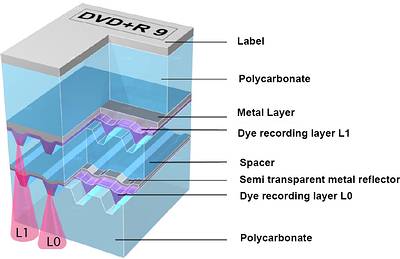DVD+RW Alliance demonstrates dual-layer DVD+R
Philips will demonstrate its new dual-layer DVD recordable technology at the
DVD+RW Alliance booth at the CEATEC JAPAN 2003 exhibition. Developed by Philips
Research in cooperation with MKM (Mitsubishi Kagaku Media)/Verbatim, the technology
virtually doubles data storage capacity on DVD recordable discs from 4.7 Gbyte
to 8.5 Gbyte while remaining compatible with existing DVD Video players and
DVD-ROM drives.
Users will benefit from the additional storage capacity of the DVD+R disc as
it will enable them to record 4 hours of DVD-quality video or 16 hours of VHS-quality
video, without the need to turn over the disc. PC users will be able to archive
up to 8.5 Gbytes of computer files on a single disc, which almost doubles the
storage capacity compared with the 4.7Gbytes for the single-layer DVD+R discs
currently available. The dual-layer DVD+R system uses two thin embedded organic
dye films for data storage separated by a spacer layer (see figure). Heating
with a focused laser beam irreversibly modifies the physical and chemical structure
of each layer such that the modified areas have different optical properties
to those of their unmodified surroundings. This causes a variation in reflectivity
as the disc rotates to provide a read-out signal as with commercially pressed
read-only discs.

Initial investigations were started by Philips Research around 2 years ago
at a time when there was general scepticism throughout the optical storage industry
that compatible dual-layer DVD recordable would ever be possible. Developments
since then, initially by Philips and later in cooperation with media manufacturer
MKM, have dispelled this scepticism and the new dual-layer DVD+R technology
is now fully endorsed by the DVD+RW Alliance.
The DVD+RW Alliance is setting an aggressive feature and performance roadmap,
and the dual-layer DVD+R format book is expected to be ready within this year.
Recorders for both the PC and consumer electronics markets are expected to become
available during the course of 2004.
Write a comment below. No registration needed!
|
|

